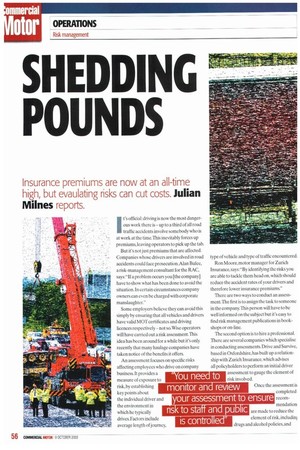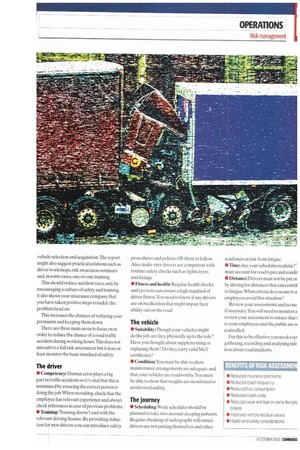SHEDDING POUNDS
Page 56

Page 57

If you've noticed an error in this article please click here to report it so we can fix it.
Insurance premiums are now at an all-time high, but evaulating risks can cut costs. Julian MiInes reports. ! t's official: driving is now the most danger ous work there is — up to a third of all road traffic accidents involve somebody who is at work at the time.This inevitably forces up premiums, leaving operators to pick up the tab.
But it's not just premiums that are affected. Companies whose drivers are involved in road accidents could face prosecution.Alan Bulee, a risk-management consultant for the RAC, says:"If a problem occurs you Ithe company] have to show what has been done to avoid the situation. In certain circumstances company owners can even be charged with corporate manslaughter."
Some employers believe they can avoid this simply by ensuring that all vehicles and drivers have valid MOT certificates and driving licences respectively — not so.Wise operators will have carried out a risk assessment.This idea has been around for a while but it's only recently that many haulage companies have taken notice of the benefits it offers.
--•::"4'ts average length of journey, type of vehicle and type of traffic encountered.
Ron Moore, motor manager for Zurich Insurance, says:"By identifying the risks you are able to tackle them head on, which should reduce the accident rates of your drivers and therefore lower insurance premiums."
There are two ways to conduct an assessment.The first is to assign the task to someone in the company.This person will have to be well informed on the subject but it's easy to find risk management publications in bookshops or on-line.
The second option is to hire a professional. There are several companies which specialise in conducting assessments. Drive and Survive, based in Oxfordshire, has built up a relationship with Zurich Insurance, which advises all policyholders to perform an initial driver assessment to gauge the element of risk involved.
Once the assessment is completed recommendation are made to reduce the element of risk, includirg drugs and alcohol policies, and vehicle selection and acquisition. The report might also suggest practical solutions such as driver workshops, risk awareness seminars and, in some cases, one-to-one training.
This should reduce accident rates,and,by encouraging a culture of safety and training, it also shows your insurance company that you have taken positive steps to tackle the problem head on.
This increases the chances of reducing your premiums and keeping them down.
There are three main areas to focus on in order to reduce the chance of a road traffic accident during working hours.This does not amount to a full risk assessment but it does at least monitor the basic standard of safety.
The driver
• Competency: Human error plays a big part in traffic accidents so it's vital that this is minimised by ensuring the correct person is doing the job. When recruiting, check that the employee has relevant experience and always check references in case of previous problems.
• Training:Training doesn't end with the relevant driving licence. By providing induction for new drivers you can introduce safety procedures and policies fel'r them to follow. Also, make sure drivers are competent with routine safety checks such as lights. tyres and fixings.
• Fitness and health: Regular health checks and eye tests can ensure a high standard of driver fitness. You need to know if any drivers are on medication that might impair their ability out on the road.
The vehicle
• Suitability:Though your vehicles might do the job, are they physically up to the role? Have you thought about supplementing or replacing them? Do they carry valid MoT certificates?
• Condition: You must he able to show maintenance arrangements are adequate and that your vehicles are roadworthy. You must be able to show that weights are monitored to avoid overloading.
The journey
• Scheduling: Work schedules should be planned to take into account sleeping patterns. Regular checking of tachographs will ensure drivers are not putting themselves and other road users at risk from fatigue.
• Tim: Are your schedules realistic?", must account for road types and condil • Distance: Drivers must not be put at by driving for distances that can contril to fatigue.What criteria do you use toe employees avoid this situation?
Review your assessments and revise if necessary. You will need to monitor a review your assessment to ensure that I to your employees and the public are st controlled.
For this to be effective you need a sys gathering, recording and analysing ink tion about road incidents.
































































































































































































